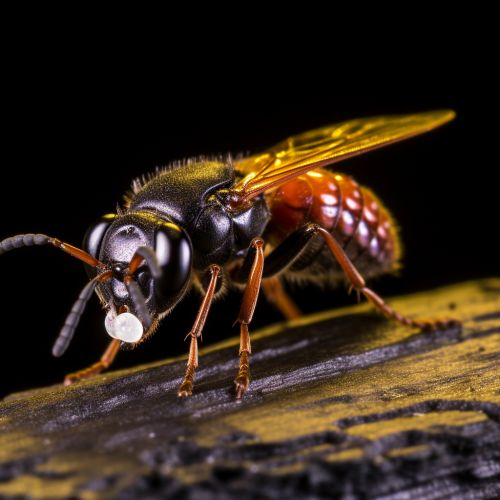Parasitoid Wasps and Pest Control
Introduction
Parasitoid wasps are a large group of hymenopteran superfamilies, with all but the wood wasps being in the wasp-waisted Apocrita. As parasitoids, they lay their eggs on or in the bodies of other arthropods, sooner or later causing the death of these hosts. Different species specialize in hosts from different insect orders, often with a preference for a narrow range of species. Despite the gruesome reputation, parasitoid wasps are highly beneficial for pest control, as they naturally regulate populations of their host species, many of which are pests for crops and humans.


Biology and Behavior
Parasitoid wasps exhibit a wide range of behaviors, life cycles, and adaptations, which allow them to effectively parasitize their hosts. Most species are endoparasitoids, meaning they lay their eggs inside their hosts' bodies. The larvae then feed on the host's tissues until they are ready to pupate. Some species are ectoparasitoids, laying their eggs on the host's body, with the larvae feeding externally.
Parasitoid wasps are known for their unique reproductive strategies. Many species are haplodiploid, a sex-determination system in which females develop from fertilized eggs and are diploid, while males develop from unfertilized eggs and are haploid. This system allows for a high degree of control over the sex ratio of offspring, which can be advantageous in certain ecological contexts.
Role in Pest Control
Parasitoid wasps play a crucial role in the natural control of pest populations. They are often used in biological pest control strategies, as they can significantly reduce the numbers of pests without the need for chemical pesticides. The use of parasitoid wasps in pest control has a long history, with the first recorded use dating back to the 19th century.
The effectiveness of parasitoid wasps in pest control is due to their specificity. Each wasp species tends to target a specific pest species, which minimizes the risk of non-target effects. Moreover, parasitoid wasps are self-regulating, as their population sizes naturally fluctuate in response to the abundance of their hosts.


Challenges and Limitations
While parasitoid wasps offer many advantages for pest control, there are also challenges and limitations to their use. One of the main challenges is the need for a thorough understanding of the wasps' biology and ecology. Factors such as the wasps' host specificity, reproductive strategies, and environmental requirements can all influence their effectiveness in pest control.
Another challenge is the potential for non-target effects. Although parasitoid wasps are generally specific to their hosts, there is still a risk that they could affect non-target species. This is particularly a concern in cases where parasitoid wasps are introduced into new environments for biological control.
Future Directions
Despite the challenges, the use of parasitoid wasps in pest control continues to be a promising field. Advances in genetic technologies, such as CRISPR-Cas9, could potentially be used to enhance the wasps' effectiveness or to create new strains with improved pest control capabilities. Moreover, ongoing research is providing a deeper understanding of the wasps' biology and ecology, which could lead to more effective and sustainable pest control strategies.
